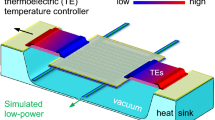Abstract
Traveling-wave electrohydrodynamic (EHD) micropumps can be incorporated into the package of an integrated circuit chip to provide active cooling. They can also be used for fluid delivery in microdevices. The pump operates in the presence of a thermal gradient through the fluid layer such that a gradient in electrical conductivity is established allowing ions to be induced. These ions are driven by a traveling electric field. Such a traveling electric field can be realized in practice only via discrete electrodes upon which the required voltages are imposed. The impact of using discrete electrodes to create the traveling wave on the flow rates generated is explored through numerical modeling. The change in performance from an ideal sinusoidal voltage boundary condition is quantified. The model is used to explore the widths of electrodes and the intervening isolation regions that lead to optimized pumping. The influence of the choice of working fluid on the performance of the pump is determined using an analytical model.






Similar content being viewed by others
References
Andersson H, Van den Berg A (2003) Microfluidic devices for cellomics: a review. Sens Actuat B Chem 92(3):315
Barthel J, Buchner R, Munsterer M (1995) Electrolyte data collection part 2: dielectric properties of water and aqueous electrolyte solutions, vol XII. DECHEMA, Frankfurt
Bohinsky BJ, Seyed-Yagoobi J (1990) Induction electrohydrodynamic pumping - Selecting an optimum working fluid. In: IEEE industry applications society (IAS) annual meeting, Seattle, WA, 7–12 October 1990, pp 795–801
Choi JW, Kim YK (1995) Micro electrohydrodynamic pump driven by traveling electric fields. In: IEEE industry applications conference, 30th IAS annual meeting, vol. 2, Orlando, Florida, 8–12 October 1995, pp 1480–1484
Crowley JM (1980) The efficiency of electrohydrodynamic pumps in the attraction mode. J Electrostat 8(2–3):171–181
Crowley JM, Wright GS, Chato JC (1990) Selecting a working fluid to increase the efficiency and flow rate of an EHD pump. IEEE Trans Ind Appl 26(1):42–49
Felten M, Geggier P, Jager M, Duschl C (2006) Controlling electrohydrodynamic pumping in microchannels through defined temperature fields. Phys Fluids 18(5):051707
Fluent (1998) FIDAP 8.7.4, finite element software
Fu AY, Chou HP, Spence C, Arnold FH, Quake SR (2002) An integrated microfabricated cell sorter. Anal Chem 74(11):2451–2457
Fu AY, Spence C, Scherer A, Arnold FH, Quake SR (1999) A microfabricated fluorescence-activated cell sorter. Nat Biotechnol 17:1109–1111
Fuhr G, Hagedorn R, Muller T, Benecke W, Wagner B (1992) Microfabricated electrohydrodynamic (EHD) pumps for liquids of higher conductivity. J Microelectromech Syst 1(3):141–146
Fuhr G, Schnelle T, Wagner B (1994) Travelling wave-driven microfabricated electrohydrodynamic pumps for liquids. J Micromech Microeng 4(4):217–226
Garimella SV, Singhal V, Liu D (2006) On-chip thermal management with microchannel heat sinks and integrated micropumps. Proc IEEE 94(8):1534–1548
Green NG, Ramos A, Gonzalez A, Castellanos A, Morgan H (2001) Electrothermally induced fluid flow on microelectrodes. J Electrostat 53(2):71–87
Horiba (2008) The story of conductivity: temperature compensation in http://www.jp.horiba.com/story_e/conductivity/conductivity_04.htm, accessed 17 March 2008
Iverson BD, Garimella SV (2008) Recent advances in microscale pumping technologies: a review and evaluation. Microfluid Nanofluid. doi:10.1007/s10404-008-0266-8 (available online)
Janssen LPBM, Warmoeskerken MMCG (1987) Transport phenomena data companion. Edward Arnold, London
Laser DJ, Santiago JG (2004) A review of micropumps. J Micromech Microeng 14(6):35–64
Lide D (2001) CRC handbook of chemistry and physics, 82 edn. CRC Press, New York
Mahajan R, Chiu C–P, Chrysler G (2006) Cooling a microprocessor chip. Proc IEEE 94(8):1476–1486
Melcher JR (1966) Traveling-wave induced electroconvection. Phys Fluids 9(8):1548–1555
Melcher JR, Firebaugh MS (1967) Traveling-wave bulk electroconvection induced across temperature gradient. Phys Fluids 10(6):1178–1185
Perch-Nielsen IR, Green NG, Wolff A (2004) Numerical simulation of travelling wave induced electrothermal fluid flow. J Phys D Appl Phys 37(16):2323–2330
Ramos A, Morgan H, Green NG, Castellanos A (1998) AC electrokinetics: a review of forces in microelectrode structures. J Phys D Appl Phys 31(18):2338–2353
Serway RA, Moses CJ, Moyer CA (2005) Modern physics, 3rd edn. Brooks Cole, Belmont
Seyed-Yagoobi J (2005) Electrohydrodynamic pumping of dielectric liquids. J Electrostat 63(6–10):861–869
Seyed-Yagoobi J, Chato JC, Crowley JM, Krein PT (1989a) Induction electrohydrodynamic pump in a vertical configuration: part 1. Theory. J Heat Transf 111(3):664–669
Seyed-Yagoobi J, Chato JC, Crowley JM, Krein PT (1989b) Induction electrohydrodynamic pump in a vertical configuration: part 2. Experimental study. J Heat Transf 111(3):670–674
Singhal V, Garimella SV (2005a) Influence of bulk fluid velocity on the efficiency of electrohydrodynamic pumping. J Fluids Eng 127(3):484–494
Singhal V, Garimella SV (2005b) A novel valveless micropump with electrohydrodynamic enhancement for high heat flux cooling. IEEE Trans Adv Packag 28(2):216–230
Singhal V, Garimella SV (2007) Induction electrohydrodynamics micropump for high heat flux cooling. Sens Actuat A Phys 134(2):650–659
Singhal V, Garimella SV, Raman A (2004) Microscale pumping technologies for microchannel cooling systems. Appl Mech Rev 57(1–6):191–221
Wolff A, Perch-Nielson IR, Larsen UD, Friis P, Goranovic G, Poulsen CR, Kutter JP, Telleman P (2003) Integrating advanced functionality in a microfabricated high-throughput fluorescent-activated cell sorter. Lab Chip 3:22–27
Acknowledgments
The authors gratefully acknowledge funding and support from the National Science Foundation, the industry members of the Cooling Technologies Research Center, an NSF I/UCRC, and the Indiana 21st Century Research and Technology Fund.
Author information
Authors and Affiliations
Corresponding author
Rights and permissions
About this article
Cite this article
Iverson, B.D., Cremaschi, L. & Garimella, S.V. Effects of discrete-electrode configuration on traveling-wave electrohydrodynamic pumping. Microfluid Nanofluid 6, 221–230 (2009). https://doi.org/10.1007/s10404-008-0317-1
Received:
Accepted:
Published:
Issue Date:
DOI: https://doi.org/10.1007/s10404-008-0317-1




